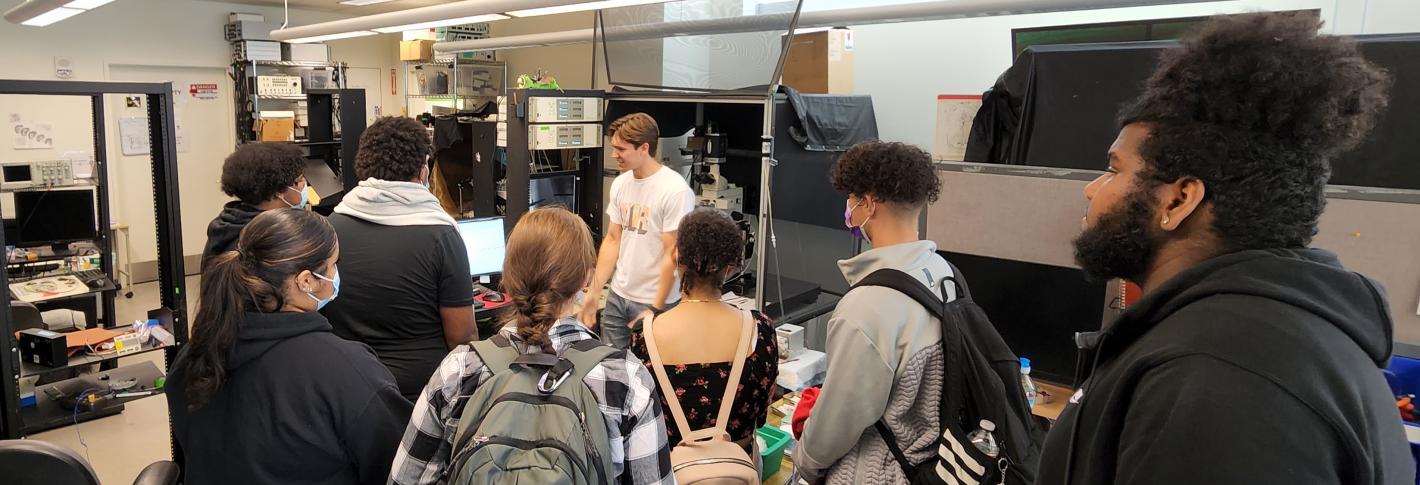
On June 21, their last day of school, 17 high school students from Lawrence did not have to come tour life sciences research labs around MIT. They were just eager to seize the opportunity, provided by their school and The Picower Institute, to learn more about science and medicine, said teacher Rebecca Veilleux.
It was the same for another 20 Everett High School students in the SEED Pathway program, who opted for a morning full of exposure to cutting edge research to build a foundation of understanding about possible science careers.
“It helps them focus on the different fields of STEM they could choose,” said Everett Academy Lead Teacher Nancy Cianchetta. “It helps them learn about more than what I could expose them to in just the classroom.”
Above: A group of students from Lawrence High School listen to Bear Lab graduate student Max Heinrich describe his autism research (white tee shirt). Image credit: David Orenstein
For instance, a group of her students got the chance to tour the stem cell facility that the lab of Picower Institute Director and Picower Professor Li-Huei Tsai relies upon to do cutting edge research on Alzheimer’s disease. There, postdocs Adele Bubnys and Rebecca Pinals showed the students how they can transform a person’s skin cells into multicellular, 3D brain tissue cultures that model important features of Alzheimer’s such as the buildup of amyloid plaques.
“You can make any cell type from anyone,” Bubnys said, explaining that the lab induces the skin cells to become stem cells and then transforms those in to neurons, brain blood vessels, immune cells and more, creating powerful lab models of human brains not only for studying disease, but also testing whether drugs can get across the blood-brain barrier that strictly filters what goes in or out of brain tissue.
At the same time, a group of the Lawrence students were visiting in the lab of Picower Professor Mark Bear to learn how postdocs David Stoppel and graduate student Max Heinrich study autism in mice modeling human genetic mutations. The scientists showed the students how they can take a slice of a mouse’s brain, mount it under a microscope and then electrically stimulate neurons and measure their electrical response. Importantly, they said, cells in the brains of mice with a particular gene knocked out are hyperactive compared to cells from control mice where the gene has been left unaffected.
The postdocs also pointed out that when Heinrich makes his measurements, he doesn’t know whether he’s working with an autism model brain or a control brain. Such “blinding,” Stoppel noted, is a crucial feature of scientific experimentation that prevents bias from affecting results.
“If you are going to do an experiment, do the experiment blinded,” Stoppel advised the potential future scientists.
Just before a pizza lunch, a couple of students from each school broke off from the pack to tour the fruit fly lab of Menicon Professor Troy Littleton, where researchers study how neurons communicate with each other and with muscles. There, Payton Dupuis and Katherine Gourianova, undergraduates visiting MIT as part of the Bernard S. and Sophie G. Gould MIT Summer Research Program in Biology, gave the students a closeup look at male and female flies and how flies are dissected for study in the lab.
“I feel as though the visit had an impact as there were a few students who asked what classes they would have to take to do something like what I had shown them,” said Dupuis, who hails from Montana State University. “Also, the students who visited were all girls so I think it helped that Katherine and I were there to show that not all researchers are men. The visit had a huge impact on me as I realized that although I do not want to go into teaching, I love doing outreach with high schoolers and showing them something that they may not have considered doing in the future.”
Meanwhile, other students from each high school continued to talk about Alzheimer’s research with Pinals and Bubnys from the Tsai lab.
In all, throughout a rich morning of tours organized by Mandana Sassanfar, Diversity and Outreach Coordinator in the Departments of Biology and Brain and Cognitive Sciences, groups of the students also toured the Whitehead Institute, the Biology department, The McGovern Institute’s Martinos Imaging Center, and the Koch Institute for Integrative Cancer Biology.
Lawrence students Darianna Sanchez and Jayden Rosario said they enjoyed learning more about at project at the Koch Institute where they saw how engineered beads can help improve drug delivery. Sanchez also liked the fruit fly demonstration.
Classmates Ethan Santiago and Evelyn Brito said they found it cool that Heinrich and Stoppel in the Bear lab could take a slice out of a brain and still keep it alive and active enough to make meaningful measurements.
Brito said she doesn’t necessarily have a career doing that in mind, per se, but that she just wanted to come to MIT for the experience.
“I just wanted to learn new things,” she said.
Even on the last day of school.




